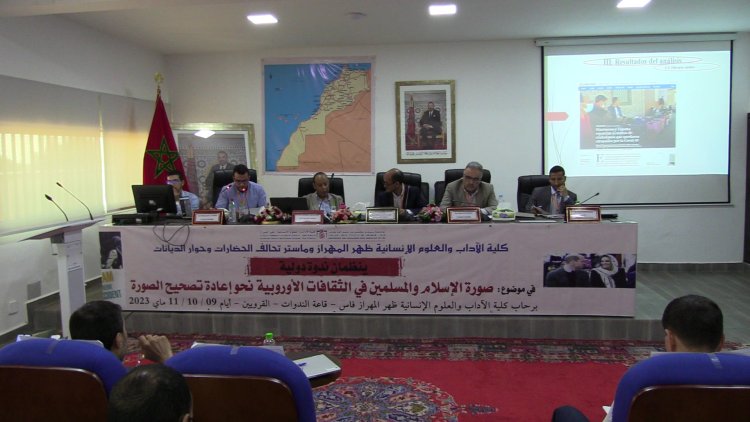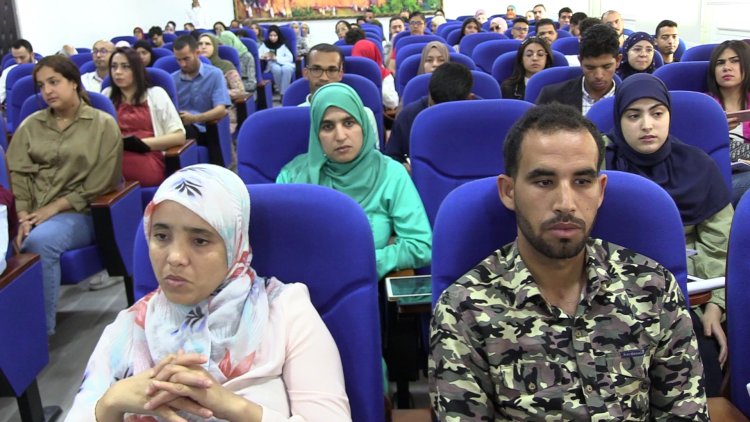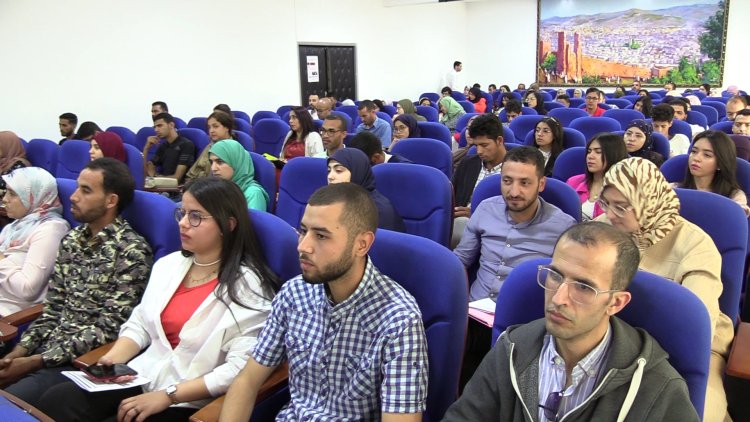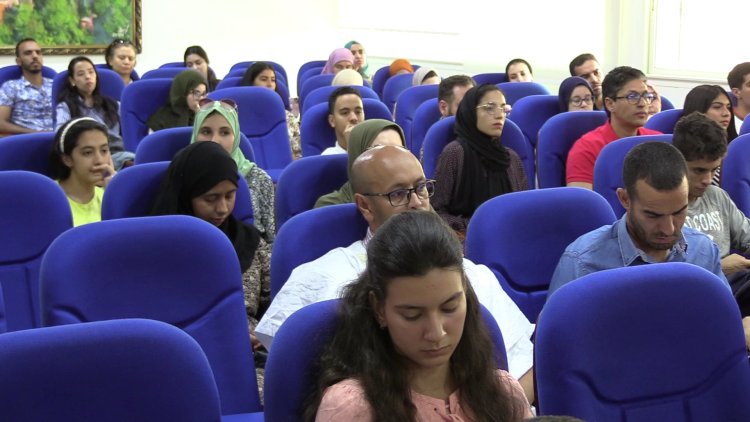Researchers from around the globe discussing : The image of Islam and Muslims in European cultures: Towards an Image Re-Correction
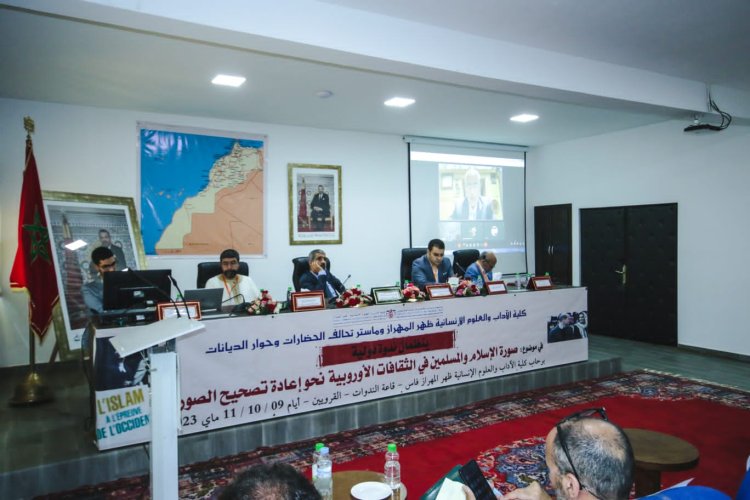
Tuesday, Wednesday, and Thursday 09th, 10th and 11th May 2023, at Al Qarawiyyine Conference room, The faculty of Arts and humanities Dhar Al-Mahraz and the Masters program: "Alliance of civilizations and interreligious dialogue", Sidi Mohamed Ben Abdellah University have organized an International Conference on: The Image of Islam and Muslims in European Cultures: Towards an Image Re-Correction.
The conference had ten scientific sessions, chaired by professors and researchers from Spain, Germany, France, Italy, Portugal, America and Chile, in addition to Moroccan researchers from the world, and professors from Moroccan universities, and from the Faculty of Arts, Dhar Al-Mahraz, as well as from other faculties affiliated to Sidi Mohamed Ben Abdellah University. The speakers delivered their interventions in Arabic, English, German, Spanish and French.
Among the panels of these sessions, we can find the following themes:
- Muslims in Europe and the experience of citizenship.
- Muslims in Europe and the religious dialogue.
- The image of Islam and Muslims in European literature.
- Islam and narrative, journalistic and artistic discourse.
- The image of Islam and Muslims in cultures Iberia.
- Civilizational dialogue and correcting the image of Islam and Muslims.
- The representations of Islam and Muslims in the Spanish culture.
Dr. Khaled Lazaar, Dean of the Faculty of
Arts and Humananities - Dhar Al-Mahraz - Fez, pointed out in his opening speech to the great role that the image plays today in our societies, whether in providing stereotypical representations or ready-made information, as well as its ability to correct misconceptions about the other, if Well employed. Hence the Dean's assertion of the currentness of the topic of this international conference in the era of globalization, fabricated conflicts, and conflicted geo-political and geo-economic interests, starting by provoking discussion and pointing to the imbalances in the image of Islam and Muslims that has been drawn by some European parties.
And in the speech of the Organizing Committee, it was stated that the organization of this international conference stems from the belief of the Faculty of Arts and Humanities - Dhar Al-Mahraz - Fez, as well as the Masters program: "Alliance of Civilizations and interreligious Dialogue ", in the importance that the image plays in forming an idea of the other, whether this image is negative or positive, objective or far from the truth and reality; in the intellectual, literary, and artistic fields, or in the political, media, humanities, and other fields. And this other - in this conference- is the "Muslims", whether in their association with Islam or in their association with Islamic culture, or in their relations with the European country in which they live, or became citizens.
Among the most important cases that the panels of the conference brought we find:
-The distorted image of Islam and Muslims, circulating today in some European cultures, is the responsibility of two parties: some Muslims who issued a distorted image of Islam and Muslims, and some Europeans who took advantage of it - with bad intentions - to distort the image even more.
-Correcting this image requires a cooperation between Muslims and Europeans with good intentions, by alerting those who have been deceived by some European media outlets as well as some extreme right-wing European political parties, to the essence and tolerance of Islam, and the role it can play in the safety and security of the world, and to the need to distinguish between Islam (the Qur’an and the Sunnah) and the Islamic culture (the understanding and interpretation of some Muslims of the Qur’an and the Sunnah), i.e. the distinction between religion and religiosity.
- The Islamic religion faces the problem of integration in Europe, as immigrants brought with them patterns of religiosity with different cultures, customs and sects, which makes it difficult for Europeans to find a single model for Muslims to address. Also, if Muslims want to obtain recognition, they must become a cultural, political and social tributary of the tributaries of the European country that receives them.
The image of Islam and Muslims created by the European imagination is divided into four images:
1- The image of the enemy at the moment of conflict
2- The image of the rival in peace.
3- The image that reflects fear and caution of Muslims.
4- The image of admiration and astonishment
The Islamic currents coming from Islamic countries to Europe are represented in three main currents: The theological current, the intellectual philosophical religious Islamic current, and the theosophical current. And it has become necessary to differentiate between philosophy and Islamic religious thought, because philosophy is absolute in terms of rationality and does not need to be described as Islamic, unlike Islamic religious thought that takes its description from its association with Islamic intellectual issues.
- The Spanish identity is built on the ruins of the Islamic identity, and yet the Spanish historical discourse is one of conflict and an attempt to erase the other, because it is linked to several problematics, including: conquest and recovery, the Tetouan War, the Green March, and the Moros brought by Franco to deter the Republicans.
-The nature of European-Islamic relations, throughout history, focuses on political, economic and commercial intersections, and ignores literary intersections, in a clear indication of the reduction of the relationship between the ego and the other in a relationship of conflict. Hence, the European writings - about Islam and Muslims - were based on biological foundations as a factor of superiority, as the white writings sought to silence colored voices, but opposition currents rejected stereotyped thinking, and rejected the myth of white human supremacy.
-Highlighting the difference between Islamic law and European laws, with the need to take into account the large increase in the number of Muslims in Europe when talking about coexistence, as Islam was and still is part of European reality. However, in recent decades, this Islamic presence has become a major challenge, especially when a Muslim wants to apply their law in a non-Muslim society, where Islamic law is a different system from the legal systems applied in Europe.
-The issue of Islamophobia in Europe and some of its manifestations that took place in Europe in the last months of the year 2023, such as: burning the Qur’an in Sweden, tearing and burning the Qur’an in the Netherlands, tearing and burning the Qur’an in Denmark, as well as some of its manifestations in Spain, where four cases of Islamophobia and racism against Islam and Muslims were recorded in the Murcia region in one month – during the year 2021 - and the racism against the Moroccan national football team that happened on March 27, 2023, as well as the attacks on Muslims during the celebration of Ramadan.
In the closing session, a number of participants in this international conference - from inside and outside Morocco - expressed the importance of the significant issues raised at the conference, and the proposals it presented to correct the image of Islam and Muslims in European cultures. They also expressed their thanks to the Dean, the scientific and the organizational committee for the event.
